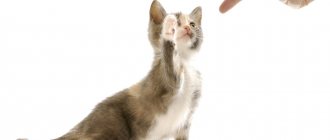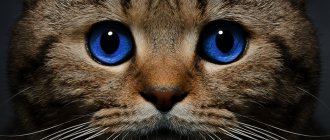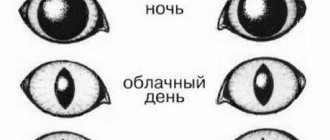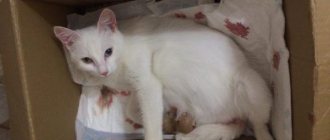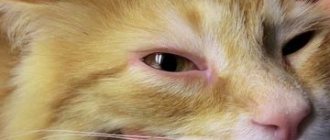Diseases that occur in pets throw many owners into a stupor; it is one thing to cope with a problem in the human body, quite another in a cat. Especially if we are talking about a rather serious ophthalmological problem.
Everyone knows that the organs of vision are not to be trifled with; at the first sign of a pathological abnormality, you must immediately seek help from specialists.
If you discover that your cat is bleeding from the eye, you should not self-medicate, as this may cost your pet his sight. With such pathologies, time plays the most important role; the earlier treatment is started, the greater the chances of success.
Normal or pathological?
Certain breeds of cats (especially Scottish, British and Persian) have a greater amount of fluid draining from their eyes. This is due to the anatomical features of the structure of the skull and the short nasolacrimal duct, the normal functioning of which is disrupted.
After sleep, any pet may also experience lacrimation. Small clots of mucus accumulate in the corners of the eyes of cats, which dry out, and the cat removes them when washing itself.
If a cat develops brown discharge from the eyes, the development of a pathological process should be assumed, especially if the disturbances persist for several days.
It is recommended to carefully monitor the pet, assess the dynamics of the disease, eliminate factors that provoke increased symptoms, and show the cat to a veterinarian. Diseases that manifest as brown discharge from the eyes can affect various parts and systems of the cat's body.
What are possible preventative measures?
There are no special preventive measures, but there is a list of general recommendations, compliance with which significantly reduces the risk of developing a pathological condition in the animal.
It is necessary to constantly monitor your pet’s claws and trim them in a timely manner. Especially if there are several cats in the family.
The pet must be carefully monitored; if the cat has never been outside, it must not be allowed to end up in an unfamiliar environment by running away from home. In such situations, pets most often return home with some kind of injury.
Common causes of non-purulent eye discharge in cats
What can cause brown discharge from the eyes of domestic cats:
- presence of a foreign object in the eye: speck or hair;
- trauma, damage to the eyelids, eyes or head;
- allergic reactions;
- anatomical features and defects, for example, narrow nasolacrimal ducts, closed lacrimal ducts (dacryocystitis), abnormal growth of eyelashes inside the eyelid (trichiasis);
- benign and non-benign tumors that mechanically compress the tear ducts.
Dark discharge from the eyes of cats can be caused by a number of infectious diseases that affect the structures of the eye. Including dark discharge appears due to inflammation of the mucous membrane of the eyes (conjunctivitis), inflammation of the cornea and mucous membrane (keratoconjunctivitis), involvement in the inflammatory process of the eyelids (blepharitis), cornea (keratitis), inflammation of the lining of the eyeball (uveitis), vascular dysfunction eyes (iridocyclitis).
Another dangerous cause of dark discharge from the eyes can be glaucoma, which develops as a result of a chronic inflammatory process, dystrophic-degenerative diseases of the organs of vision, or after eye surgery.
By the nature of the discharge from the eyes, its color and consistency, one can presumably determine the underlying pathology that caused the discharge. With bacterial conjunctivitis and keratitis, the exudate is predominantly purulent, yellow, green or light brown.
If the infectious disease is of viral origin, then there is no purulent discharge, and the owner observes cloudy, thick mucus. When you have cat flu, the discharge is milky in color. In case of infectious diseases, you should pay attention to the general condition of the cat: as a rule, it becomes lethargic and loses its appetite.
A common cause of brown discharge from the eyes in cats is epiphora. This condition occurs due to the closure of the nasolacrimal passages and causes itching, dermatitis and hair loss in the periorbital area.
In case of allergic reactions, eye injuries and foreign body penetration, profuse lacrimation and redness of the eyes appear. In healthy animals, it is considered normal if a clear, odorless liquid is released from the eyes in a minimal volume, and such lacrimation disappears after a short time.
Diagnostics
If the owner notices brown discharge around the cat's eyes, he needs to take the pet to a veterinary clinic. In most cases, examination and history is sufficient to make a diagnosis.
Sometimes it is necessary to conduct additional tests to help rule out head and eye injuries, as well as diseases of internal organs and infectious diseases. To do this you may need to do:
- Ultrasound of the organs of vision;
- X-ray of the skull;
- blood and stool tests.
Signs of a serious illness
Experts identify quite a few diseases that provoke poor blood clotting. In case of illness, the animal may also experience other symptoms - for example, red spots on the ears and gums, pale gums. Also, the cat may not want to get out of bed in the morning and will lie all day due to loss of strength and lethargy.
Reduced blood clotting in cats can occur due to diseases such as viral leukemia and viral immunodeficiency. It can be caused by side effects of anti-inflammatory drugs. Another common reason is as a result of pathologies of the systems responsible for blood clotting, for example, disseminated intravascular coagulation syndrome, liver failure, hemophilia. Severe purulent discharge with blood from the eyes or nose may also indicate the presence of worms.
Diseases and pathologies that cause disturbances in the outflow of tears from the eyes through the lacrimal ducts
This group includes:
- Narrowing of the tear ducts of an inflammatory nature.
- Stenosis of the lacrimal openings (too small tubules).
- A foreign object that has entered the lumen of the lacrimal canal.
- Eye injury, as a result of which the functioning of the lacrimal system was disrupted.
- Dacryocystitis (non-infectious inflammation of the lacrimal sac).
- Allergy.
- Tumors, neoplasms, compressing tubules.
© shutterstock
How to help your pet
If your pet has discharge that may be a sign of eye disease, it is recommended to seek help from a veterinarian. The specialist will conduct a diagnosis, determine the pathology and prescribe treatment. If necessary, you can wash your cat's eyes yourself at home. For this purpose, an aqueous solution of furatsilin
,
saline solution
or
herbal decoctions: chamomile, calendula, loose leaf tea brews
.
To carry out this procedure on an adult cat, it must be carefully secured by wrapping it in a cloth or towel. It is more convenient to do this together with an assistant.
If the eyelashes are stuck together and crusts appear on the cat’s eyelids, you should blot them with a gauze swab soaked in a furatsilin solution, then carefully clean the eyes with movements from the inner corner to the outer. Additionally, you should clean your pet's nose, eyebrows and cheeks.
After washing, the eyes are instilled with medications as prescribed by the veterinarian. To avoid infection, it is necessary to regularly examine your pet, clean the eye area if dirt accumulates, limit contact with possible allergens and sick animals, monitor the diet, increase the cat’s nutrition with vitamin and mineral complexes, vaccinate the animal and carry out regular deworming.
Sources:
https://kinpet.ru/u-koshki-korichnevye-vydeleniya-iz-glaz-prichiny-i-lechenie/
https://infokotiki.ru/zabolevania/gl/u-kota-iz-glaza-techet-krov.html
https://aquatech-spb.ru/koshki-bolezni/krov-iz-nosa-u-kotenka.html
Treatment
As an emergency, the cat should be calmed and an ice pack or any other cold object placed on its nose. After this, you should immediately call a specialist. After performing the above tests, the cause of the bleeding is determined. Next, a course of treatment is prescribed aimed at eliminating the pathology causing dysfunction of the body. As a rule, we are talking about taking medications: tablets, mixtures, compresses. In exceptional cases (for example, in the presence of a tumor), surgery is used.
Additional reasons
Unfortunately, there are many more possible causes of nosebleeds:
- Advanced infections of the nasal cavity, especially purulent rhinitis. If during an illness the mucous membrane of the nasal cavity has been damaged and weakened, blood can gushing out at any moment.
- Pulmonary edema and bleeding. In this case, so much blood can be released that it not only drips, but literally gushes from the nostrils.
- Liver and kidney diseases. Few people remember that these organs are an integral part of the blood coagulation system, and therefore, with severe functional pathologies, the blood may stop clotting normally.
- Poisoning with rat poisons. All these substances block the same blood coagulation system. As a rule, this happens to cats in rural areas. They either eat the poison themselves, or eat a poisoned rodent.
- Parasitic diseases. In particular, with intensive infestation by parasitic nematodes, worm larvae can greatly damage the lungs during their migration.
- Fungal infections. Some types of pathogenic fungi are capable of destroying the tissues of the nasal cavity no worse than cancerous tumors. Of course, this process is always accompanied by heavy bleeding. In addition, copious amounts of pus can often be seen in the leaking blood.
Causes of bleeding and degree of danger
Bleeding is caused by many different factors. The most common reasons: injuries, infectious diseases, the presence of parasites, dental problems, unstable functioning of the circulatory system, heat stroke, poisoning, etc.
The exact source can only be determined by a specialist.
If blood appears due to injury, there is a risk of inflammation. Often it affects the entire respiratory system and gives rise to new diseases. When bleeding is observed from both nostrils, this is a clear sign of clotting problems.
A young pet—especially a kitten—is at serious risk under these circumstances. If you do not contact a veterinarian in time, the situation can get much worse. In particularly advanced cases, death is possible.
If no pathologies are detected
In order not to provoke a new attack, the animal is protected from stress. This helps stabilize emotional levels and pressure.
You cannot leave a cat on the street unattended: it can suffer from the actions of street animals, damage the nasal mucosa from hard leaves and thorns of plants, and their seeds.
It is important to undergo regular veterinary and dental examinations . This will prevent the development of inflammatory processes.
A nutritious diet with the introduction of vitamin complexes is the best prevention of anemia and a decrease in the level of platelets in the blood.
First aid for nosebleeds in animals
Having noticed that the pet is bleeding from the nose, the owner must calm down himself, and then carefully examine the animal to determine the degree of complexity of the situation. After this, it is necessary to calm the animal to avoid an increase in blood pressure. There is no need to give sedatives or other medications without consulting a veterinarian.
In case of severe bleeding, you need to apply a cooling compress by applying ice to the animal’s nose. If your cat does not get better over time, you should immediately consult a doctor.


